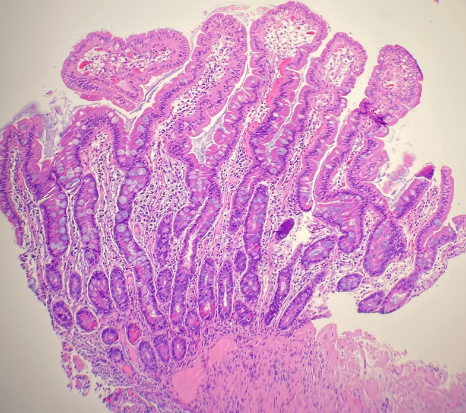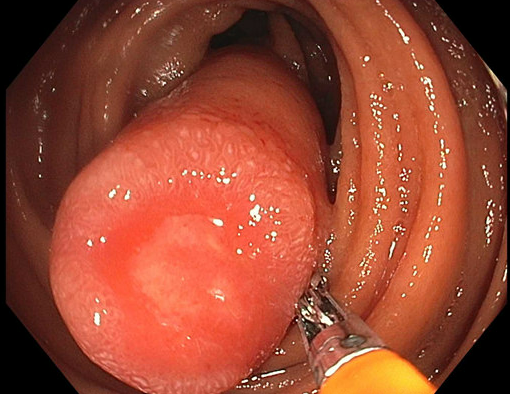Sunday Poster Session
Category: Small Intestine
P1974 - An Unexpected Source of GI Bleeding: Enteric Muco-Submucosal Elongated Polyp in the Proximal Jejunum With Literature Review
Sunday, October 26, 2025
3:30 PM - 7:00 PM PDT
Location: Exhibit Hall

Galvin Dhaliwal, MD
HCA Healthcare
Kingwood, TX
Presenting Author(s)
Galvin Dhaliwal, MD1, Dev Patel, BS2, Ashvin Singh Dhaliwal, MD3, Aakriti Soni, MD4, Bilal Ashraf, MD5, Shane Sweeney, MD1, Sushovan Guha, MD, PhD6, Ahmed Ouni, MD7
1HCA Healthcare, Kingwood, TX; 2University of Houston, Houston, TX; 3Dayanand Medical College and Hospital, Ludhiana, Punjab, India; 4HCA Houston Healthcare Kingwood, Kingwood, TX; 5HCA Healthcare Kingwood Hospital/University of Houston, Kingwood, TX; 6Houston Regional Gastroenterology Institute and University of Houston, Sugar Land, TX; 7HCA Healthcare, Houston, TX
Introduction: Enteric muco-submucosal elongated polyps (EMSEPs) represent a rare poorly characterized
entity within the spectrum of gastrointestinal polypoid lesions. While most documented cases
involve the colon, their occurrence in the small intestine remains uncommon. We present a case of an 85-year-old man with iron deficiency anemia (IDA) who was noted to have a large jejunal
EMSEP with stigmata of recent hemorrhage (SRH).
Case Description/
Methods: 85-year-old man with no past medical history on prophylactic Aspirin presented for evaluation of
IDA. Imaging revealed colonic diverticula, small hiatal hernia, and proximal small bowel fat
densities. EGD revealed mild gastritis, negative for H. pylori and celiac disease, and
colonoscopy showed sigmoid diverticulosis, hemorrhoids, and a 3 mm cecal tubular adenoma.
For further evaluation, a small bowel enteroscopy was performed, which showed a 10 mm
subepithelial nodule in the third portion of the duodenum consistent with lipoma and a large
lesion (5 cm long) with SRH in the proximal jejunum (Figure 1). Biopsy revealed preserved
villous architecture with focal acute inflammation (Figure 2). The lesion was clinically diagnosed
as EMSEP. Patient chose not to proceed with endoscopic resection as his hemoglobin was
stable on periodic iron infusions.
Discussion: EMSEPs are often asymptomatic and may present incidentally during endoscopic evaluation.
Their potential to cause symptoms including bleeding, anemia, or bowel obstruction, as
evidenced by our patient’s presentation of anemia and the identification of a large, elongated
lesion in the jejunum, underscores EMSEPs’ clinical significance. This is a unique presentation,
as most cases of EMSEPs are found in the colon, and there is limited literature describing their
occurrences in the small bowel. Furthermore, the lesion in our case had SRH-a salient finding
that is not typically described in the literature. These polyps are characterized by their elongated
shape and a histological composition involving mucosal hyperplasia, submucosal fibrosis,
elongated glands, fibrotic stroma, and mild inflammatory changes. However, as noted in our
case, histology can sometimes be nondiagnostic. The absence of definitive histological findings
is in line with other reports that describe cases of EMSEPs with varying degrees of diagnostic
clarity. This case highlights the need for thorough small bowel evaluation in unexplained anemia
and ongoing research to improve EMSEP diagnosis and management.

Figure: Figure 1 - Elongated polyp seen in the proximal Jejunum

Figure: Figure 2 - Intermediate power image of Jejunal biopsy showing unremarkable small bowel mucosa
Disclosures:
Galvin Dhaliwal indicated no relevant financial relationships.
Dev Patel indicated no relevant financial relationships.
Ashvin Singh Dhaliwal indicated no relevant financial relationships.
Aakriti Soni indicated no relevant financial relationships.
Bilal Ashraf indicated no relevant financial relationships.
Shane Sweeney indicated no relevant financial relationships.
Sushovan Guha indicated no relevant financial relationships.
Ahmed Ouni indicated no relevant financial relationships.
Galvin Dhaliwal, MD1, Dev Patel, BS2, Ashvin Singh Dhaliwal, MD3, Aakriti Soni, MD4, Bilal Ashraf, MD5, Shane Sweeney, MD1, Sushovan Guha, MD, PhD6, Ahmed Ouni, MD7. P1974 - An Unexpected Source of GI Bleeding: Enteric Muco-Submucosal Elongated Polyp in the Proximal Jejunum With Literature Review, ACG 2025 Annual Scientific Meeting Abstracts. Phoenix, AZ: American College of Gastroenterology.
1HCA Healthcare, Kingwood, TX; 2University of Houston, Houston, TX; 3Dayanand Medical College and Hospital, Ludhiana, Punjab, India; 4HCA Houston Healthcare Kingwood, Kingwood, TX; 5HCA Healthcare Kingwood Hospital/University of Houston, Kingwood, TX; 6Houston Regional Gastroenterology Institute and University of Houston, Sugar Land, TX; 7HCA Healthcare, Houston, TX
Introduction: Enteric muco-submucosal elongated polyps (EMSEPs) represent a rare poorly characterized
entity within the spectrum of gastrointestinal polypoid lesions. While most documented cases
involve the colon, their occurrence in the small intestine remains uncommon. We present a case of an 85-year-old man with iron deficiency anemia (IDA) who was noted to have a large jejunal
EMSEP with stigmata of recent hemorrhage (SRH).
Case Description/
Methods: 85-year-old man with no past medical history on prophylactic Aspirin presented for evaluation of
IDA. Imaging revealed colonic diverticula, small hiatal hernia, and proximal small bowel fat
densities. EGD revealed mild gastritis, negative for H. pylori and celiac disease, and
colonoscopy showed sigmoid diverticulosis, hemorrhoids, and a 3 mm cecal tubular adenoma.
For further evaluation, a small bowel enteroscopy was performed, which showed a 10 mm
subepithelial nodule in the third portion of the duodenum consistent with lipoma and a large
lesion (5 cm long) with SRH in the proximal jejunum (Figure 1). Biopsy revealed preserved
villous architecture with focal acute inflammation (Figure 2). The lesion was clinically diagnosed
as EMSEP. Patient chose not to proceed with endoscopic resection as his hemoglobin was
stable on periodic iron infusions.
Discussion: EMSEPs are often asymptomatic and may present incidentally during endoscopic evaluation.
Their potential to cause symptoms including bleeding, anemia, or bowel obstruction, as
evidenced by our patient’s presentation of anemia and the identification of a large, elongated
lesion in the jejunum, underscores EMSEPs’ clinical significance. This is a unique presentation,
as most cases of EMSEPs are found in the colon, and there is limited literature describing their
occurrences in the small bowel. Furthermore, the lesion in our case had SRH-a salient finding
that is not typically described in the literature. These polyps are characterized by their elongated
shape and a histological composition involving mucosal hyperplasia, submucosal fibrosis,
elongated glands, fibrotic stroma, and mild inflammatory changes. However, as noted in our
case, histology can sometimes be nondiagnostic. The absence of definitive histological findings
is in line with other reports that describe cases of EMSEPs with varying degrees of diagnostic
clarity. This case highlights the need for thorough small bowel evaluation in unexplained anemia
and ongoing research to improve EMSEP diagnosis and management.

Figure: Figure 1 - Elongated polyp seen in the proximal Jejunum

Figure: Figure 2 - Intermediate power image of Jejunal biopsy showing unremarkable small bowel mucosa
Disclosures:
Galvin Dhaliwal indicated no relevant financial relationships.
Dev Patel indicated no relevant financial relationships.
Ashvin Singh Dhaliwal indicated no relevant financial relationships.
Aakriti Soni indicated no relevant financial relationships.
Bilal Ashraf indicated no relevant financial relationships.
Shane Sweeney indicated no relevant financial relationships.
Sushovan Guha indicated no relevant financial relationships.
Ahmed Ouni indicated no relevant financial relationships.
Galvin Dhaliwal, MD1, Dev Patel, BS2, Ashvin Singh Dhaliwal, MD3, Aakriti Soni, MD4, Bilal Ashraf, MD5, Shane Sweeney, MD1, Sushovan Guha, MD, PhD6, Ahmed Ouni, MD7. P1974 - An Unexpected Source of GI Bleeding: Enteric Muco-Submucosal Elongated Polyp in the Proximal Jejunum With Literature Review, ACG 2025 Annual Scientific Meeting Abstracts. Phoenix, AZ: American College of Gastroenterology.
